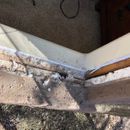How to retrofit block frame window into stucco (zone 2B)?
We are considering upgrading windows in a Tucson condo. Our neighbors with identical layout and construction just had their windows replaced, and I watched the process for a while. I’ve casually read some articles @ GBA, BSC, and JLC, and I don’t recall anything about a) retrofitting and b) into stucco. The process the installers used does not represent anything I remember being recommended.
I’ll try to attach a picture, but basically after taking the old window frames out, the wall is just 2x, thin tar paper, about 1” of EPS rigid foam, and then stucco. The window installers then placed a “block frame window” (no flanges of any sort), screwed thru the window frame into 2x, and then just caulked inside and outside. So…no pan flashing, no end flashing, no back dam or slope, no nothing. I have no experience in this area, and I’m from the Michigan (no stucco construction, very different climate).
Question: is a close fit and caulking enough, given the hot dry climate, and no windows facing north?
GBA Detail Library
A collection of one thousand construction details organized by climate and house part










Replies
Hi Andrew -
Ah, climates with less than 20 inches of rain annually....
You CAN get away with a "face-sealed" approach in your climate: your primary moisture barrier is your cladding linked to openings/penetrations by way of sealants. But, you need to do the sealant the way it is intended; see these blogs I wrote on liquid sealants, including using the right sealant for the right conditions as well as the right dimensions of the bead and the right backer rod: https://www.buildinggreen.com/search/site/sticky%20business.
Peter
I would disagree a bit bit with Peter Yost above, and say, "it depends."
In desert areas, there's not much rain to leak into walls, and a face-sealed approach can work as Peter indicates above. However, when there is rain, there is often a LOT of rain at one time. I've got friends who perform building evaluations in AZ, and they tell me that water issues are one of their biggest complaints, despite being in a desert. It seems that since they are in a desert, builders routinely ignore all guidance for water management, as you saw with your neighbor's window replacement. Most of the time they get away with it. But when the rains come and water starts pouring out of window openings, people get unhappy.
That thin tar paper in your photo is the water barrier (WRB) for the building, and windows, doors and other penetrations should still be flashed to it, even in the desert. This process is difficult for retrofit work in every climate, and it is often ignored in every climate. The good news for you is that ignoring the flashings in a desert is not as bad as ignoring flashings in a wet climate. You will still get leaks, but they won't cause as much harm. You might not even notice them. If nothing else, an aluminum or vinyl flashing could be slipped up behind the paper at the head, and another one formed into a pan below the window. The windows would then be installed exactly as you saw, but they would have some water protection for the inevitable storms.
It might even be possible to find a contractor who understands what you want and is willing to do it.
Peter and Peter - thanks for your replies. In fact it's the very heavy monsoon rains that I'm most concerned about, but...man, it's hot in the direct sun out here. Seems like it should dry out anything.
It's possible that I could get some good windows at a discount (wrong size ordered for different job), so I'd like to use this company if I could. Perhaps if I supplied several sizes of backer rod and some alternative sealant/caulk to the installation crew.
P.S. Regarding bead dimensions - I have rarely seen backer rod used, and I don't think I've ever seen a trades person use anything other than a finger for tooling. Hopefully they aren't using saliva.